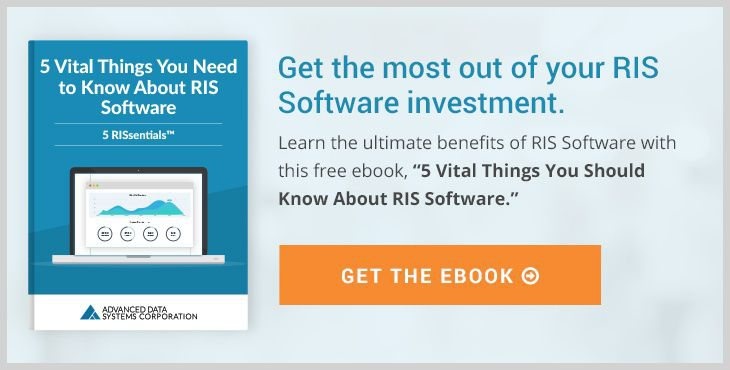5 Tips on How to Leverage a Radiology Information System to Improve Your Practice
Savvy physicians and medical practice managers alike know how important it is to take full advantage of the software and computer technology supporting their daily work in examining, diagnosing, and treating patients. This means that while you may have installed a radiology information system on the premises, you aren’t necessarily getting everything out of it.
Just having a RIS doesn’t automatically make you an efficient, revenue-generating practice. Your team needs to use it in the right way to get the best return on your investment. What follows are some simple tips that you can implement to do just that, which pave the way toward even more detailed information in our free, informative ebook, “5 Vital Things You Need to Know About RIS Software.” You’ll gain more insight into why running a radiology practice isn’t easy and how a RIS can remove many important compliance issues, such as MACRA and HIPAA. Your practice will function more smoothly if you allow technology solutions to enable your staff.
Get the most out of your RIS Software investment. Learn the ultimate benefits of RIS Software with this free ebook, "5 Vital Things You Need to Know About RIS Software."
1. Referrals
You need to manage all referrals through your RIS, for the best use of time and effort. Think of all the referrals you get each year from local physicians. Are you taking steps to make sure you are taking care of them as efficiently as possible? Radiologists need to reduce the amount of time and overhead involved in keeping track of new patients and the details of their cases.
By allowing the RIS to do the majority of the work and integrating it with your other computer systems as well as other practices’ systems (from their primary care provider, hospital, or emergency room prior to coming to your office), you can reduce labor spend and generate many more patients.
2. Patient Engagement
Chances are you will have already integrated your RIS with electronic health records or EHR software that includes provisions for a patient portal. You will want to encourage patients to use the portal from the privacy of their home, as it lets them log in using their own computer or mobile device.
The unique front-end interface you establish for patients helps boost engagement. Patients will stay interested in between appointments, using the system to check in on information, such as the results of a recent test. They can use the portal to ask your staff questions more easily (without having to call and wait on hold to leave a message with a receptionist), and the staff can reply at their convenience with the ease of writing an email. All information will be protected robustly to keep you in compliance with HIPAA and other privacy regulations.
A computerized patient portal reduces how much work you ask of patients before their first appointment since they can enter their personal details one time only in the system instead of writing it by hand on forms that often request the same information redundantly. This saves your staff time too, since they no longer have to transcribe the details into your system. It’s also easier for patients to provide feedback so you can continue to improve your practice and demonstrate to patients your desire to meet their needs.
3. Training
A RIS designed with efficiency in mind allows each member of your team to take care of patient information using fewer clicks of the mouse, less typing, and less time getting up and down from a seat to fetch forms or scan a document. But this increase in efficiency won’t happen overnight, just because you’ve installed a RIS.
It’s essential that you arrange for each employee to be thoroughly trained in using a radiology information system when first installed as well as when the system is upgraded. If a member of your team discovers a new way to be more efficient, it will be time to hold a quick training seminar to implement the change across the board.
4. Simple Records and Images
How much time does your team spend every day keeping track of images, patient records, and other details on treatment? Keeping all these details accessible from a single place is possible thanks to your radiology information system.
Doctors are proven to be more focused, and their practices will be able to offer faster and higher quality care, with a reduced need for staff to fight against the system just to get things done. Look for a RIS with an easy and intuitive user interface, and make sure that the software developer makes upgrades on a regular basis, to keep the RIS following industry best practices.
5. Magnify the Benefits of Automation and Workflows
Using a radiology information system by itself will definitely bring increased efficiency and better workflow to your practice. But to really take advantage of the RIS, some synergy is called for. When you couple your RIS with other efficient systems, such as electronic health records, electronic medical records, and practice management software, the RIS can bring you benefits that are greater than the sum of their parts.
This is the position many radiology practices find themselves in now, with many more practices now in transition. While almost every field tends to lag behind the pace of consumer technology developments, many patients, staff, and physicians expect to interact with a bare minimum level of technology during their time spent in the office.
Key Takeaway:
- The fact that you have installed a radiology information system in your radiology practice does not mean you are automatically working more efficiently now.
- You can manage referrals better and bring in more revenue by using a RIS to its full capabilities.
- Patient engagement is improved when you harness the front-end interface between your patients and the RIS.
- Using a RIS requires fewer mouse clicks and keystrokes for your staff to get the same amount of work done faster, and it is a vital training tool.
- Your RIS is great for keeping all patient records, images, and other details accessible from a convenient, central location.
- Combining your RIS with other systems designed to increase efficiency, such as electronic health records and practice management software, will bring you more benefits than when considered individually.
Mere possession of a RIS doesn’t automatically equal maximization of your resources. You can learn how to do that here. Why should you expand your knowledge about radiology information systems? If you’re paying for a RIS but are not getting everything out of it that you could, you might be leaving revenue and efficiency on the table. For more information about radiology information systems, download our free e-book, “5 Vital Things You Need to Know About RIS Software.”
About Christina Rosario
Christina Rosario is the Director of Sales and Marketing at Advanced Data Systems Corporation, a leading provider of healthcare IT solutions for medical practices and billing companies. When she's not helping ADS clients boost productivity and profitability, she can be found browsing travel websites, shopping in NYC, and spending time with her family.




